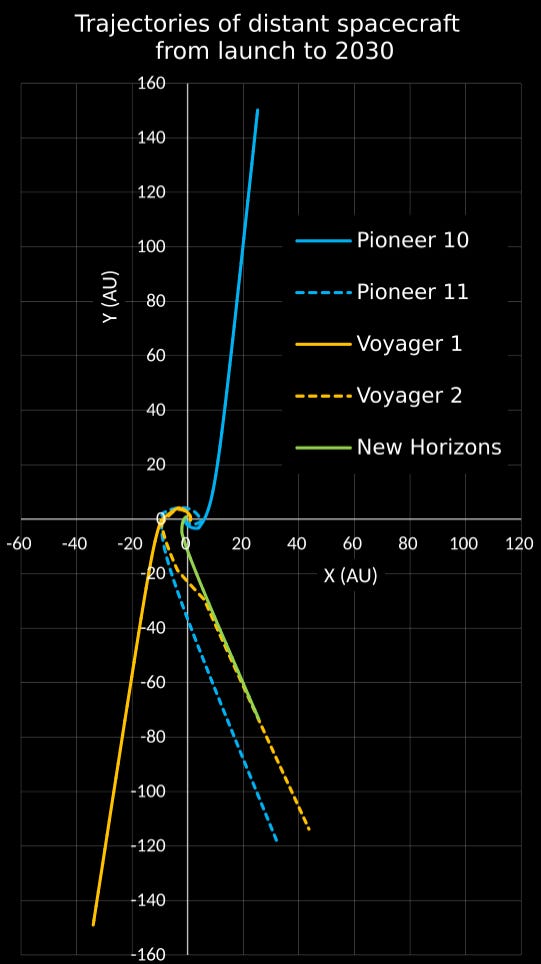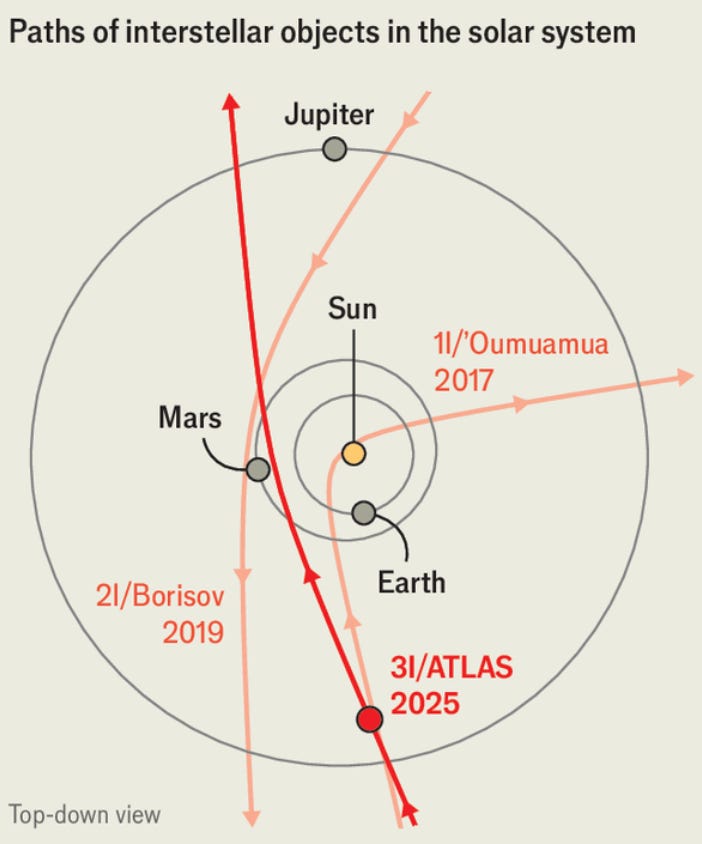The Most Intriguing thing about 3I/ATLAS is how it is being Ignored
What is 3I/ATLAS and where did it come from?
There’s something interesting that has been heading our way. I’m not talking about a Great Reset, financial collapse, another pandemic or false flag event. I’m talking about an object moving towards the inner solar system at breakneck pace. First spotted by the Asteroid Terrestrial-impact Last Alert System (ATLAS) station at Río Hurtado, Chile, on July 1st, 2025, the object called 3I/ATLAS will be reaching its closest point to the Sun (its perihelion) later this month.
Details from Wikipedia (if you believe that source) are vague with regard to its size (0.2 to 3.5 miles in diameter) and period of rotation. The scientific consensus offers nothing spectacular. Of note, however, is that
3I is emitting CO2 much more than water
it is emitting Nickel much more than Iron vapor
detection of Nickel vapor was before Cyanide gas
it had been emitting a dust plume towards its direction of motion, not away
These features, I have learned, are not typical of comets but neither are they Earth-shattering, literally or figuratively—3I will not be colliding with our planet, in case you were interested.
The thrust of this essay centers around two extraordinary facts. The first is that unlike the tens of thousands of newly identified objects that approach us and leave every few years, 3I/ATLAS is not from our solar system. The second is that the scientific community seems to be unimpressed by this fact.
To see why their response is so peculiar we have to understand not only how rare such visitors are but why they are so rare. Most of the source material I am using for this article can be quickly extracted through basic Chat GPT queries.
Since the the turn of the century tens of thousands of new objects on Near Earth trajectories are being identified each year. They are elements of our solar system which was created by the accretion of interstellar dust which led to the formation of the Sun, planets and comets a few billion years ago.
Everything in our solar system either orbits the Sun or planets which in turn orbit the Sun.
3I/ATLAS doesn’t.
How often do we host objects from outside the solar system? To our knowledge, never, at least until eight years ago when a cigar shaped object was spotted leaving the inner solar system at a clip exceeding the escape velocity of the Sun. Such a thing had never been seen before.
A new nomenclature had to be introduced. The object was named 1I/’Oumuamua. ‘Oumuamua is the Hawaiian word for “a messenger from afar arriving first” (it was discovered by Robert Weryk using the Pan-STARRS telescope at Haleakalā Observatory in Hawaii).
“I” for interstellar. And “1” because it was the first of its kind.
Just two years later another interstellar object was identified: 2I/Borisov. Today there is 3I/ATLAS. A graze through the internet will lead you to believe that this sort of thing has probably been happening regularly outside our notice. Nothing really to see here folks.
Methods of detection are much better now. More and bigger telescopes are pointed at the heavens, automated image processing allows for detection of tiny objects which are moving against a field of relatively motionless stars. Why be so surprised that we have only recently become aware of interstellar objects in our solar system?
But we have been cataloguing thousands of new objects in our solar system every month for decades and only three have been confirmed to be from outside our solar system. They all have appeared in the last eight years. If this was nothing new we should have been picking these things up for a while. We haven’t. According to this source, we have been spotting roughly the same number of new objects since the turn of the millennium yet only these three have been interstellar.
There isn’t a lot of stuff between the stars. It all gets mopped up by stellar gravitational fields over time. This also makes it impossible for an object from another star system to find its way out, unless it possesses a significant amount of kinetic energy to begin with. This should lead us to ask, is it even possible for an object to leave one solar system and enter another?
Well, we know that it can happen. Our species has sent five spacecraft on trajectories with enough velocity to leave our solar system:
The center of the axes is the Earth from a polar view. Notice how the paths of these craft begin with tight turns near the start of their epic journeys but straighten further out. This is because their trajectories were designed to harness the gravitational fields of planets on their path which served to bring them in and then fling them off towards the next, picking up enough momentum so that they will eventually leave the solar system.
But these were objects launched from Earth with multi-staged rocket engines and “slingshotted” along. What about natural objects?
There are known, natural phenomena that can impart an object like 3I with enough kinetic energy to escape a star’s gravitational field.
It is generally thought that objects like 1I, 2I and 3I must have originated from supernovae, a violent end of life event which stars of a certain mass experience. Supernovae explosively eject material and energy throughout the galaxy.
3I approached us from the general direction of the constellation of Sagittarius, which is known to be an area of several supernovae. It gets complicated when examining things that are very far away from us. These supernovae are tens of thousands of light-years away, which means we are observing them as they appeared tens of thousands of years ago. If 3I originated there, even if it was put on a direct course to us, it would not arrive for tens of millions of years. If 3I was the product of a supernova it must have occurred elsewhere and much further in the past.
I asked AI to list some of the best studied supernovae events around us to find the older and closer ones. The best candidate for 3I/ATLAS origin is…
Vela Supernova Remnant: This is one of the closest known supernova remnants to Earth, located approximately 900 light-years away. It is the result of a Type II supernova explosion that occurred about 11,000 years ago. The Vela Supernova Remnant is a complex structure with filaments and shock waves that are still expanding and interacting with the interstellar medium.
Even if we use 3I/ATLAS’s maximum velocity at perihelion (about 1/5000 the speed of light) a non-stop flight to the Earth would take 4.5 million years. It also would have approached our solar system from a significantly different angle.
The other possibility is that during the formation of a star cluster the object may have been flung from the area due to a coincidental interplay between gravitational fields between the fledgling suns.
I asked AI to list some of the star forming regions in the general direction of Sagittarius, their approximate ages and distances from Earth. We encounter the same problem. They are too far away and too young appearing to be responsible for birthing 3I. (The best candidate was the Trifid Nebula, 300,000 years old and 4,100 light years away).
Given the fact that there doesn’t seem to be a supernovae or nebulae in the general direction from which 3I is arriving that is close and old enough to be its source, it must have been slaloming interstellar space for billions of years, whipping around star systems that launch it in one direction and the next so that it eventually found itself here.
The nearest star system in the direction from which it is thought to have originated is called Ross 154, about 9.7 light-years away. If 3I had once been speeding its way to Ross 154, the star (or another in that general direction) could have redirected it towards home sweet home.
Given its present speed (about 0.02% the speed of light) it would have taken 3I about 50 thousand years to get here, a blink of an eye in a cosmic time frame. But the more intriguing part of this hypothesis is the astounding accuracy Ross 154 must have demonstrated in redirecting 3I towards us. 3I came within 1.4 AU (Astronomical Units) of the Sun. An AU is the distance between the Earth and the Sun, about 93 million miles.
Proportionally it would be the equivalent of a bullet 0.3 inches in diameter, say from a Mauser 30-06 (a bullet I have become intimately familiar with recently) hitting a bulls-eye dead on from about three miles away. I suppose if Ross 154 was a highly trained sniper with a properly calibrated scope adjusting for “solar winds” it is a possibility, especially if the experts tell us there are no other theories under consideration.
From the diagram above you can see that compared to 1I, 3I and 2I were relatively errant bullets which sought the Sun as a target. 1I/’Oumuamua got seven times closer to the target than 3I, an even more astounding example of cosmic marksmanship.
Of course the Sun is not an inert target, it draws anything with mass towards it. However 3I is officially moving along at around 58km/sec, almost twice the velocity required to leave the solar system. And its path is highly eccentric (e > 6), indicating that it is passing through at nearly a straight line. This means that it already had a pretty good bead on us before our Sun began to draw it in.
Yes, 3I could have been put on its path towards us eons ago through natural phenomena. But what about 1I and 2I? Is it unreasonable to ask if someone is shooting at us?
Not only has 3I been moving towards the Sun with stunning accuracy, unlike its predecessors, its path is nearly level with the ecliptic, the plane on which the planets orbit the Sun. If the solar system was a flat target, 3I managed to strike it edge on. This means that it will travel in proximity to several planets as well much like the probes we have launched. Is it also unreasonable to ask if someone out there isn’t shooting at us maybe they are curious about what’s going on in our solar system these days?
Avi Loeb, Professor of Science and previous Director of of the Institute for Theory and Computation at the Center for Astrophysics at Harvard University, thinks its a perfectly reasonable question.
As early as July of this year Loeb was already worried that 3I is an Alien Probe and the scientific community should take notice. Establishment scientists disagree. Tom Statler, NASA’s lead scientist for solar system small bodies, told The Guardian:
“It looks like a comet. It does comet things. It very, very strongly resembles, in just about every way, the comets that we know.”
“It has some interesting properties that are a little bit different from our solar system comets, but it behaves like a comet. And so the evidence is overwhelmingly pointing to this object being a natural body. It’s a comet.”
But here’s NASA’s own definition of a comet:
“Comets are cosmic snowballs of frozen gases, rock, and dust that orbit the Sun”
But Statler and the entirety of the establishment acknowledge that 3I doesn’t orbit the Sun. Wikipedia also repeatedly refers to 3I/ATLAS as an “interstellar comet”, an oxymoronic term. Is the misdirection deliberate or is this an innocent oversight (I think it’s the former)?
Statler’s argument is that because it “behaves” like a comet the evidence is “overwhelmingly pointing to this object being a natural body.” That’s neither an argument nor overwhelming evidence. While he and all other establishment astronomers conspicuously decline to address any of the undisputed peculiarities I have mentioned here, some nevertheless openly deride Loeb’s suggestions.
Professor of Astrophysics at Arizona State University Steve Desch, PhD is reported as saying that Loeb is
“conflating the good science we do with this ridiculous sensationalism and sucking all the oxygen out of the room.”
Conclusion
Objectively speaking,
nobody knows what 3I/ATLAS is or where it came from
given the undisputed and remarkable peculiarity of 3I’s trajectory and speed relative to our solar system, there ought to be more thoughtful statements coming from the experts
there seems to be an effort to downplay the arrival of this object
it is only logical to conclude that it is a natural body if we refuse to consider the existence of a non-human intelligence behind it
It is this last point which is of the most interest to me. Let us say that Extraterrestrial intelligence in the universe was a given. Which theory would garner the most support?
Most scientists would agree that there must be intelligent life out there. The MilkyWay galaxy, let alone the known Universe is far too big and too old to have life emerge on our planet exclusively of everywhere else. One doesn’t have to be an astronomer or biologist to see this.
This is where things get murky. Because the public is only aware of technology which would make an interstellar journey possible but too long to be practical, we sleep well at night accepting that ETs are probably out there but most definitely not here. It’s a comforting but illogical story.
Why are we so dismissive of the idea that these interstellar “comets” might be exploratory probes launched eons ago given that we ourselves sent our own on their way in the recent past? Is it because these objects don’t have dish antennae or Plutonium‑238 powered thermo-electric generators like the Voyager craft?
Let us for a moment envision the best version of ourselves ten thousand years from now. Free energy devices are powering the world. Every individual has their basic needs met. War has become obsolete and our species cooperates at a global scale. We have developed technologies which we cannot imagine right now. What would the spacecraft we build look like and how would they function?
Perhaps we would reflect on this current time as a crucial turning point in our history. Perhaps we would have become aware that every planetary civilization reaches the very same moment in their evolution where they choose a path of either peace and cooperation or endless conflict and eventual self-destruction. Wouldn’t we be interested in how neighboring planetary civilizations who were at this juncture were doing? How would we know if they were ready to be introduced to the neighborhood?
I suggest that if we had the wisdom to pick peace and cooperation for ourselves we would also see the harm in interfering with another civilization’s path. Sustained peace cannot be enforced from the outside. It must be chosen from within.
If ten thousand years from now we were to send a craft to probe another solar system known to have life in possession of the technology we have today I think that we would pick a design which would belie its purpose so that we could observe a civilization without interfering with it too much.
Maybe we would pick something that looks like a comet, does comet things and very, very strongly resembles, in just about every way, the comets that they would know.
Perhaps 3I/ATLAS isn’t here to scan us as much as it is to offer a reminder about the limits of our understanding and nudge us to a period of self-reflection. Maybe this isn’t the first time this is happened.
Who was responsible for the lines of Nazca, the two thousand year old geoglyphs etched into the desert floor of the Nazca Desert in southern Peru? Perfectly straight lines that stretch for kilometers and zoomorphic designs that can only be appreciated from hundreds of feet in the air despite appearing in nearly two hundred square miles of relatively flat desert? Why would anyone do something like this?
What about the strange patterns that have been appearing in fields for centuries? These “crop circles”, some spanning over 10 acres are known to convey sophisticated mathematical concepts with stunning precision and haunting beauty.

And then there is the pyramid of Giza. Conventional archeologists portray it as an ancient and curious monument while ignoring the elephant in the room: we couldn’t build it today with our cranes and excavators. Two million stones cut with hair-breadth tolerances? Slabs of granite weighing 70 tons hoisted and placed high over its base and positioned perfectly? Its near perfect alignment to true north? We forget that it had once been covered with a gleaming limestone casing. Imagine how an explorer to the region would have reacted three thousand years ago upon seeing this structure standing 500 feet over the desert floor:
We can guess what they would have thought:
How on Earth could anybody have built this?
If people did build it, where did they leave all their tools? Whoever built it must have took their tools and technology with them leaving behind a shimmering 17 acre wide mystery that remains standing at least five thousand years later.
Is it so unreasonable to think that if there were ETs who wished to introduce themselves to us they would see the harm in simply showing up at the White House or Kremlin unannounced? Maybe they have learned that they have to drop a few clues over the years to see how we react first.
Or does someone have a better explanation?
At the very least 3I’s presence is reminding us that those in charge have conceptual blind spots, are being disingenuous, or both.
So to the NASA scientists who mock all other hypotheses, I understand you think there is a perfectly reasonable natural explanation for 3I showing up. But what is it? And from where did it come from? Can you be a little more specific than “out there somewhere”?
Please share your thoughts in the comments.






Listening to the Light: What 3I/ATLAS Might Be Telling Us About Intelligence, Propulsion, and Perception
Humans are creatures of sound. Our biology is tuned to vibration—ears shaped to catch waves in air, minds trained to decode meaning from pitch and rhythm. Even our technologies reflect this bias: radios, sonar, and interstellar messages encoded in electromagnetic echoes of our auditory instincts.
But what if intelligence elsewhere never evolved with sound?
What if their perception developed in silence—attuned not to pressure waves, but to the curvature of spacetime, the shimmer of mass in motion, the whisper of photons bending under engineered weight?
This isn’t fantasy. It’s a challenge to our assumptions.
Just as we once believed Earth was the center of the cosmos, we now risk assuming our sensory palette defines the universal language of communication and travel.
Then came 3I/ATLAS.
A Comet—or Something Else?
Discovered in 2023, 3I/ATLAS is the third confirmed interstellar object to pass through our solar system. But unlike its predecessors, it exhibits behaviors that defy conventional cometary physics:
• Anti-tail anomaly: Instead of streaming away from the Sun, its jet points toward it—a rare and poorly understood phenomenon.
• Nickel-rich, iron-free emissions: It ejects about 4 grams of nickel per second, with no detectable iron—a composition not seen in natural comets.
• Slow dust ejection and faint coma: These features suggest atypical sublimation behavior, possibly pointing to exotic material properties or engineered shielding.
• Deliberate motion: Its trajectory and speed appear unusually restrained for an interstellar object, prompting speculation about intentional deceleration.
These anomalies have led some researchers—including Harvard’s Avi Loeb—to entertain the possibility that 3I/ATLAS might be more than just a rock. Not as a conclusion, but as a hypothesis worth exploring.
The Physics of Light-Speed Travel—And a Speculative Twist
In theoretical physics, photons are massless, yet they carry momentum. This principle underlies concepts like solar sails and laser-driven propulsion. But what if a civilization could go further—infusing photons with effective mass through exotic fields or quantum coupling?
Such a system might:
• Manipulate inertia to reduce resistance at relativistic speeds
• Use mass-infused light beams to create directional thrust without conventional fuel
• Achieve near-light-speed travel by bending the rules of radiation pressure and momentum transfer
If 3I/ATLAS were equipped with such a system, its anti-tail could be a directed energy plume—part propulsion, part sensor array. Its nickel-only emissions might reflect engineered alloys designed for heat resistance, stealth, or electromagnetic control.
And if it slowed near our star, it might not be a malfunction. It might be observation. A pause. A moment of listening—not with ears, but with instruments tuned to the chaos and beauty of our electromagnetic noise.
Why the Nickel Matters
In most cosmic bodies, nickel and iron are inseparable. They form together in supernovae and are chemically similar, often alloyed. If nickel is present, iron should be too.
But 3I/ATLAS emits nickel without iron.
This suggests selective sublimation or engineered separation—something not explained by standard thermal or chemical models. In metallurgy, nickel is prized for its heat resistance, corrosion protection, and magnetic properties. If this object were artificial, a nickel-rich composition could reflect intentional design for durability near stars or for stealth.
It’s not proof. But it’s a clue.
Cosmic Humility
We send probes. We watch planets. We slow down to study what matters.
Why assume others wouldn’t?
The story of 3I/ATLAS invites us to reconsider what intelligence might look like—not just in form, but in perception. It challenges our assumptions about propulsion, communication, and the quiet ways observation might occur.
Whether natural or not, 3I/ATLAS reminds us: anomalies are where understanding begins.
We need to keep our minds open to many hypotheses. It always amazes me that people calling themselves “scientists”, think all phenomena can be measured ,and possibly dismissed, by their existing yardsticks.